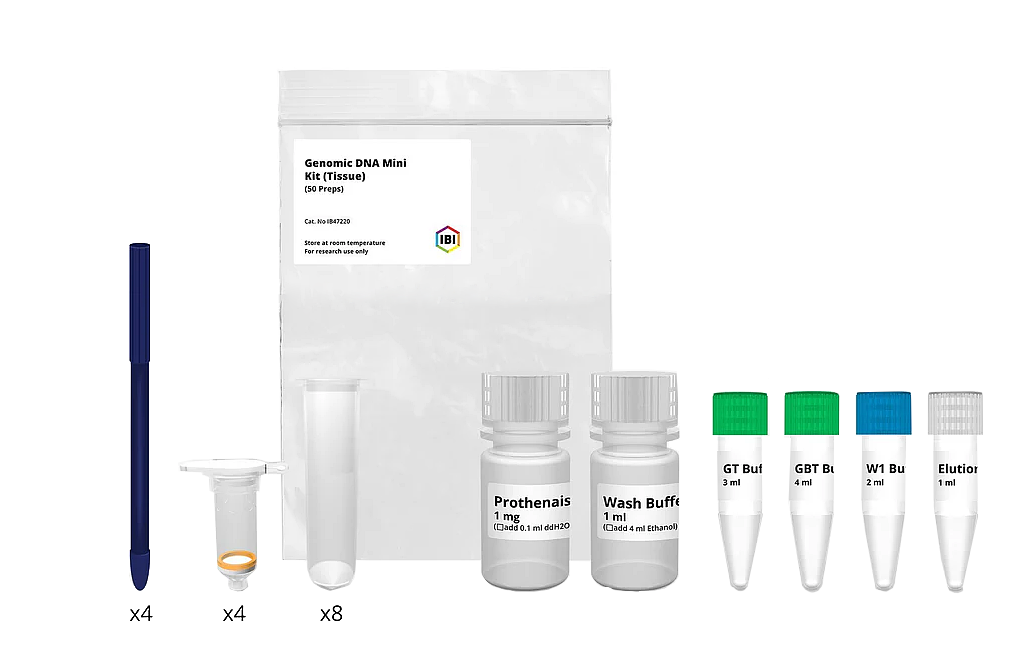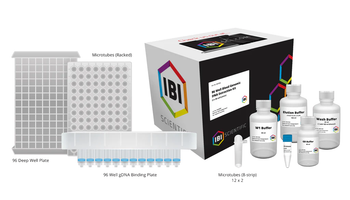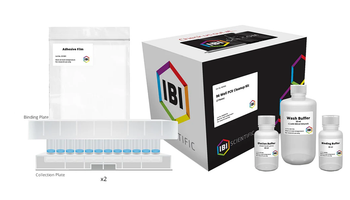
- Item Description
- Specifications
- Operation Manual
- Technical Information
- Replacement Buffers
- Replacement Columns & Collection Tubes
- Sample Size: up to 30mg tissue/up to 25mg paraffin-embedded tissue/buccal swab/up to 15ml amniotic fluid
- Expectant Yield: up to 50µg DNA
- Operation Time: 60min or less
- Elution Volume: 50-200µl
- Binding Capacity: 50µg
- Free sample available upon request
The Genomic DNA Mini Kits for Tissue are specially designed for purification of total DNA (including genomic mitochondrial and viral DNA) from a variety of animal tissues and cells. The provided micropestle can efficiently homogenize tissue samples to shorten the time in the lysis step. This method uses Proteinase K and a chaotropic salt to lyse cells and degrade proteins. The DNA in the chaotropic salt is bound by the glass fiver matrix of the spin column. After contaminants have been removed, the purified DNA is eluted by a low salt elution buffer or water. This entire procedure can be completed in under 60 minutes without phenol extraction or alcohol precipitation. The expected yield of genomic DNA is up to 50 µg and the purified DNA (with approximately 20-30 Kb) is suitable for PCR or other enzymatic reactions.
The quality of the Genomic DNA Mini Kit for Tissue is tested on a lot-to-lot basis by isolating genomic DNA from a 20 mg mouse liver sample. The purified DNA (more than 10 µg with an A260/A280 ratio of 1.7 – 1.9) is quantified with a spectrophotometer and checked by electrophoresis.
| Specifications | Mini DNA Kit (Tissue) |
| Format: | Spin Column |
| Binding Capacity: | 50 µg |
| Sample Type: | tail snips, liver, kidney, brain, adipose tissue, ear punches, insects, etc. |
| Sample Concentration: | 30 mg of animal tissue |
| Micropestle: | Yes |
| Enzyme: | Proteinase K |
| Typical Yield: | 10-20 µg (0.5 cm of mouse tail, 20 mg of mouse liver) 20-50 µg (20 mg of mouse kidney) |
| Elution Volume: | 30-200 µl |
| Operation Time: | 30 minutes |
What competitor’s kit is comparable? QIAGEN DNeasy Blood & Tissue Kit is comparable to IBI’s Genomic DNA Kit.
Can the micro pestle be autoclaved? Yes the micro pestle can be autoclaved.
How is the DNA bound to the glass fiber matrix of the GD column? Is it by charge? If so, do RNA and DNA each have a different charge and that’s how only DNA (or only RNA) binds to the column? Or, do RNA and DNA share the same charge and the RNAse changes the charge of the RNA so it doesn’t bind to the DNA column? Chaotropic salts in the buffer create a hydrophobic environment. Under this hydrophobic condition, nucleic acid will bind to the silica membrane. In addition, the cations from the chaotropic salt positively charge the silica membrane, which facilitates the binding of nucleic acids. The function of RNAse A is to digest the RNA fragments into small pieces, not to alter the charge of RNA.














